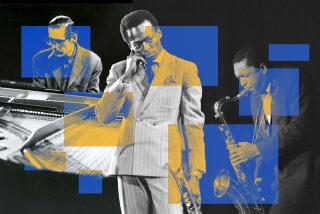Miles Davis in a Nehru jacket
Two compelling forces, improvisation and surging rhythms, drove Sunday’s “Miles From India” performance, which opened the 2008 Grand Performances season at California Plaza with an exploration of the commonalities shared by jazz and Indian classical musics.
Nearly 20 musicians took part in the event, which was centered on the recent “Miles From India,” a two-CD recording produced by composer-arranger Bob Belden as a “grand gesture at reconciliation between disparate musical cultures bound together by a universal truth. Music.”
Belden chose Miles Davis’ music as the vehicle for his “reconciliation” for several reasons: the wide-open improvisational narratives of Davis’ works from the ‘70s and ‘80s, the modal qualities of earlier pieces, and the subtle connections between the spiritual aspects of Indian music and the unspoken presence of a spirituality of community in Davis’ recordings.
The first half of the evening was devoted to acoustic pieces from the Davis oeuvre. Belden’s arrangements made slight metric adjustments -- the bass-driven underpinning of “So What,” performed with his usual brilliance by Ron Carter -- was transformed to an offbeat 9/4 rhythm. The plaintive phrases of “All Blues” emerged over a 5/4 rhythm.
Those are not rhythmic meters that are as challenging for most jazz musicians today as they might have been 20 years ago, and the interaction -- especially during an exhilarating exchange between jazz drummer Ndugu Chancler and mridangam drummers Anantha Krishnan and Sridar Parthasarathy -- often found the symbiotic point of contact between the cultures.
The melodic improvising, however, had its apples and oranges aspects, which were particularly noticeable in the offerings of the Indian players. The skills of sitarist Ravinda Chary, vocalist Shounak Abhisheki and violinist Kala Ramnath seemed disoriented within material -- “All Blues,” for example -- in which their raga-driven phrases were out of sync with a harmonic environment.
They were far more effective in the program’s electrically oriented second half, most notably in the pieces, such as “In a Silent Way,” that provided the sort of atmosphere in which their complex melodic melismas and ornamentation could rove freely across multi-layered rhythmic foundations.
The soloing jazz players -- principally Carter, keyboardists Robert Irving and Adam Holzman, alto saxophonist Rudresh Mahanthappa and, especially, trumpeter Wallace Roney -- sounded more comfortable, regardless of the setting.
Unrestricted by the specificity of a classical system, as the Indian players were, they found inspiration in all of the material’s varied aspects. But they too seemed most liberated in the electric numbers, coming together with the Indian players in a fashion that affirmed Belden’s search for the “universal truth” of music.
More to Read
The biggest entertainment stories
Get our big stories about Hollywood, film, television, music, arts, culture and more right in your inbox as soon as they publish.
You may occasionally receive promotional content from the Los Angeles Times.










